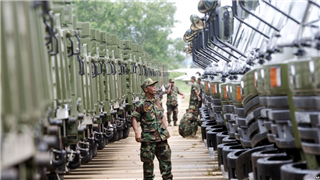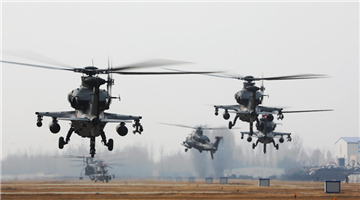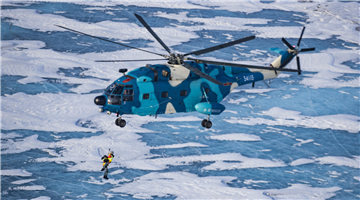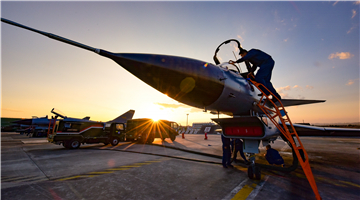By Hu Xiaodao
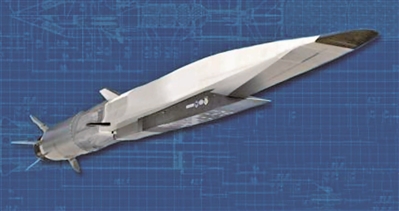
Design drawing of the Zircon hypersonic missile
Contest between the US and Russia around the Intermediate-Range Nuclear Forces Treaty (INF Treaty) has escalated recently, leading to a fierce spat. The Russian media reported on February 24 that if Russia was threatened by US missiles, Russian military would use its ultimate weapon, the Zircon hypersonic missile, to strike against the five military decision-making centers of the US.
Russia-1 of the All-Russia State Television and Radio Broadcasting Company reported on February 24 that the Russian military will use Zircon hypersonic missiles to fight back if Russia is under missile threat from Washington.
Possible targets of the Zircon include the Pentagon in Washington, D.C., the government control center in Camp David in Maryland, US President’s office and the command center of the Joint Chiefs of Staff in Fort Ritchie, Maryland, the strategic offensive forces command in McClellan, California, and the point of control of nuclear power in Jim Creek in Washington state.
Different opinions
Is it feasible for Russia to use the Zircon hypersonic missile to attack US military command posts? There are different opinions. Overall, the media and related parties analyzed the plan from three aspects: launch, penetration and destruction power of the missiles.
The first is the launch issue. According to the information disclosed by the Russian military and media, the Zircon being developed is a sea-based hypersonic missile with a range of more than 1,000 km.
The launch platforms include the Admiral Nakhimov and Pyotr Veliky (Peter the Great) battle cruisers, the unmanned underwater vehicle Poseidon which is being developed, the Project 22800 Karakurt-class corvette and the Project 21630 Buyan-class corvette.
The missile needs to be launched about 500 km from the enemy's coastline. Because the US military has a relatively complete strategic and tactical reconnaissance system, the most feasible platform would be a small missile ship or an unmanned underwater vehicle if the Russian military wants to launch a Zircon missile before the US military discovers it. The former model has been practiced on the Syrian battlefield.
The second is the penetration issue. Russian President Vladimir Putin said that the cruising speed of the Zircon hypersonic missile was 9 Machs. The 44 ground-based mid-course interceptors deployed in Alaska and California will not be able to do anything about that speed.
In addition, Russian military experts said that if Russia deploys two or three surface ships or submarines in the Atlantic and Pacific oceans respectively, it can simultaneously launch about 40 Zircon missiles. This saturation attack can beat any active anti-missile system in the US military.
The third is the destruction issue. Among the five major targets listed by the Russian media, the three targets on the east coast of the US have established relatively strong protective facilities underground.
For example, the Alternate National Military Command Center (ANMCC) near the Camp David is an underground fortress wrapped in granite. It can withstand a medium-sized nuclear strike. If a Zircon missile strikes there, it can only achieve a symbolic rather than a substantial blow. As for the other two targets on the US' east coast, although the Russian military can effectively damage them, it will not have much impact on the strategic command of the US.
Possible escalation of the game
For its part, the Russian government did not comment the Russian media list of possible US military command sites that could be targeted by Zircon hypersonic missiles.
Russian presidential press secretary Dmitry Peskov said that President Putin never detailed any specific geographical locations when he mentioned the possible launch of Zircon hypersonic missiles, adding that the Kremlin doesn't issue relevant policy that empower it to interfere with the edit of any TV station. "In the event America deploys short and medium-range missiles at Russia’s border to target us…, we will have to act reciprocally and target our missiles not just at the US’s launchers, but also at those areas where the decision-making centers are situated."
The US official’s response to the Russian media's breaking news is cold. The US media is extremely concerned. The Wall Street Journal and other media outlets believe that the news will intensify the tension between the US and Russia and boost a new round of arms race.
Daryl G. Kimball, Executive Director of the Arms Control Association (ACA), and others believe that the Russian move is a strategy aimed at re-engaging the US in negotiations on the strategic balance between the two major powers.
In general, since the US began its withdrawal process from the INF Treaty, US-Russian relations have deteriorated drastically. The two sides are frequently exchanging words. The US proposed to develop new hypersonic missiles and strategic long-range artillery with range over 1,600 km. Russia said that it will develop an army version of the Caliber-M cruise missile with a maximum range of more than 4,500 km.
Russian President Putin warned that the Russian armed forces are ready if the US wants to stage a Cuban Missile-style crisis. Russia-1's disclosure of the strike plan against US military command is a deliberate behavior. It intended to send a strong signal to the US and demonstrate Russia's strong strategic deterrent capability in frontier military power. In the future, the contest between the US and Russia around the INF Treaty will become increasingly fierce, deserving continuous attention.
(The author is Hu Xiaodao. The article was published on the Chinese Defense Newspaper on March 4, 2019. It is translated from Chinese into English and edited by China Military Online.)


